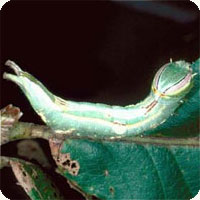Population Regulation
Mechanisms regulating bird populations are poorly understood and controversial. Here, we provide evidence that a migratory songbird, the black-throated blue warbler (Dendroica caerulescens), is regulated by multiple density-dependence mechanisms on its breeding quarters.
Project description:
 We are investigating the factors that determine the size of migratory songbird populations. Our focal species for this research is the black-throated blue warbler (Dendroica caerulescens).
We are investigating the factors that determine the size of migratory songbird populations. Our focal species for this research is the black-throated blue warbler (Dendroica caerulescens).
What is Population Regulation?
Scientists have long been interested in how animal populations are controlled, or regulated. A fundamental question in ecology is: what keeps populations from becoming too numerous or from going extinct? The size of regulated populations tend to grow when the density of individuals is low, and tend to decline when population density is high. This phenomenon is called “density dependence.”
Although many animal populations fluctuate as if regulated, the mechanisms that generate regulation in nature are poorly understood. Elucidating these mechanisms is essential for predicting how populations will respond to environmental perturbations such as habitat fragmentation or climate change.
Why Study This Bird?
Unlike many migratory songbird species, black-throated blue warbler populations have remained ![]() relatively stable since the 1960s. This stability allows us to examine the natural processes that cause the warbler’s population to vary over time.
relatively stable since the 1960s. This stability allows us to examine the natural processes that cause the warbler’s population to vary over time.
We have monitored black-throated blue warblers at Hubbard Brook Experimental Forest in the White Mountains of New Hampshire for over 30 years. Our research has shown that breeding habitat quality influences this species':
- population density,
- age structure: the recruitment of young males into the breeding population is positively correlated with nesting success in the previous summer (
 Figure 1),
Figure 1), - and reproductive output which declines as the density of birds increases (
 Figure 2)
Figure 2)
Although the latter relationship is strong evidence for regulation, the mechanism(s) underlying regulation in this population, as well as for those of any migratory songbird, remains elusive.
For instance, the pattern shown in Figure 2 could be explained by the following mechanisms:
- Crowding - as population size increases, interactions between warblers (e.g. competition for food or mates), or between warblers and their predators decrease productivity
- Site Dependence - as the population size increases, some birds are forced to occupy poorer quality territories. These low-quality sites have less food and more predators.
Recently, we tested for the effects of crowding and site dependence in our study population.
Test for Crowding Mechanism:
- reduce the neighborhood density experienced by focal pairs of warblers
- compare behavior and reproductive success between 2 treatments: a normal-density control and a reduced density group, which consisted of pairs whose neighbors had been experimentally removed
Results of Test for Crowding Mechanism:
This density reduction experiment yielded clear demographic and behavioral differences in the two treatments.
Birds in the reduced-density treatment:
- fledged more young (
 Figure 3)
Figure 3) - had larger territories with more food
- made more food deliveries to nestlings
- spent more time foraging and less time defending territories from other black-throated blue warblers
This experiment demonstrated that neighboring conspecifics can affect warbler reproductive success and behavior, and therefore that crowding is an important regulatory mechanism operating in this population.
Test for Site Dependent Mechanism:
We randomly selected 50 black-throated blue warbler territories on our study site and quantified the following variables over a 3 year period:
- vegetation density
- food abundance
- nest predator abundance
Results of Test for Site Dependent Mechanism:
The territory sites differed markedly in all measures of suitability; these differences among sites were predictable, and black-throated blue warblers responded to these differences (![]() Figure 4).
Figure 4).
For example,
- older males occupied sites with greater leaf density than did yearling males
- returning birds that shifted sites between breeding seasons moved to sites with greater leaf density than their previous territory
- Sites that were occupied in all 3 years of the study, i.e., the presumed best sites, had greater leaf density in the shrub layer, had more caterpillars, the warbler’s primary food, and had fewer nest predators than those occupied for only one or two years
These differences in site characteristics corresponded with significant differences in annual production of young. Poor sites, when occupied, produced only about half the number of young on average when compared to good sites. Thus, quality of individual sites (territories) affects reproductive performance in this species, which is a key condition for a site dependent regulatory mechanism.

Saddled Prominent (Heterocampa guttivita: Notodontidae), a caterpillar eaten by Black-throated Blue Warblers
© Lacy L. Hyche
Our results, combined with a computer simulation model, demonstrate that songbird populations can be regulated solely by the negative feedback on reproductive success generated by warbler density. This density-dependent negative feedback seems to be caused by both crowding and site dependence mechanisms. To date, therefore, the results from our long-term demographic monitoring, the density reduction experiment, site suitability measures, and computer models suggest that population regulation in our study species, and probably other songbirds, is is the result of multiple negative mechanisms.
SMBC Investigator:
Collaborators:
- Nicholas L. Rodenhouse, Wellesley College
- Richard T. Holmes, Dartmouth College


